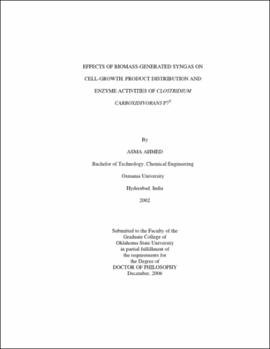| dc.contributor.advisor | Lewis, Randy S. | |
| dc.contributor.author | Ahmed, Asma | |
| dc.date.accessioned | 2013-11-26T08:31:36Z | |
| dc.date.available | 2013-11-26T08:31:36Z | |
| dc.date.issued | 2006-12 | |
| dc.identifier.uri | https://hdl.handle.net/11244/7151 | |
| dc.description.abstract | Scope and Method of Study: | |
| dc.description.abstract | Previous results showed that biomass-generated syngas caused (1) cell-washout from a chemostat due to cell-dormancy, (2) cessation of hydrogen uptake due to hydrogenase inhibition and (3) product re-distribution in the microbial catalyst Clostridium carboxidivorans P7T. The focus of this work was to investigate the factors responsible for these effects in order to overcome cell-dormancy and inhibition of hydrogen uptake for improving the fermentation process. Three goals were addressed in this work: (1) to overcome cell-dormancy due to biomass-syngas (2) to eliminate cessation of hydrogen consumption due to hydrogenase inhibition and (3) to increase ethanol production by regulating the metabolic pathway of the microbial catalyst. | |
| dc.description.abstract | Findings and Conclusions: | |
| dc.description.abstract | The studies conducted resulted in the following conclusions: (1) Additional cleaning of biomass-syngas using a 0.025-microm filter prevented cell-washout. (2) Cell-dormancy was caused by particulate contaminants (likely tars) of the biomass-syngas. (3) Cells could adapt to tar after prolonged exposure and start growing. (4) Tars caused an increase in ethanol and decrease in acetic acid production. (5) Use of a cell-recycle system prevented cell-washout, and allowed the cells to adapt to and grow on biomass-syngas (without additional cleaning). (6) Hydrogenase inhibition was caused by nitric oxide (7) A kinetic model was developed which indicated that nitric oxide inhibition was non-linear and non-competitive. (8) Nitric oxide also inhibited initial cell-growth and caused an increase in ethanol production. (9) Nitric oxide caused the alcohol dehydrogenase activity to increase. (10) Addition of neutral red, an artificial electron carrier, resulted in an increase in ethanol and decrease in acetic acid production. (11) Neutral red also caused an increase in alcohol dehydrogenase activity. | |
| dc.format | application/pdf | |
| dc.language | en_US | |
| dc.rights | Copyright is held by the author who has granted the Oklahoma State University Library the non-exclusive right to share this material in its institutional repository. Contact Digital Library Services at lib-dls@okstate.edu or 405-744-9161 for the permission policy on the use, reproduction or distribution of this material. | |
| dc.title | Effects of biomass-generated syngas on cell-growth, product distribution and enzyme activities of Clostridium carboxidivorans P7t | |
| dc.contributor.committeeMember | Johannes, Arland H. | |
| dc.contributor.committeeMember | Foutch, Gary Lynn | |
| dc.contributor.committeeMember | Huhnke, Raymond Leroy | |
| dc.contributor.committeeMember | Bellmer, Danielle D. | |
| osu.filename | Ahmed_okstate_0664D_1987.pdf | |
| osu.accesstype | Open Access | |
| dc.type.genre | Dissertation | |
| dc.type.material | Text | |
| thesis.degree.discipline | Chemical Engineering | |
| thesis.degree.grantor | Oklahoma State University | |
